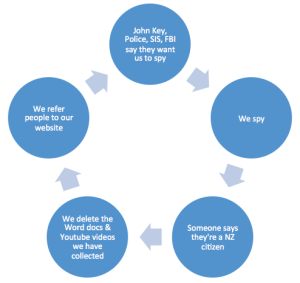Journalists have asked if I was one of the 85 New Zealand citizens or residents who were spied upon under SIS warrants, which the
Kitteridge report
says were also spied on (illegally) by the Government Communications Security Bureau. That illegal spying ran from April 2003 to September 2012.
My first reaction was that I probably wasn’t one of those 85 people. Then I checked my SIS file (which I obtained from the agency in late 2008) and found that there were two SIS reports, dated 10 September 2003 and 24 September 2003, where the SIS was monitoring preparations for my trip to Sri Lanka in October 2003, a trip that was not at that stage public knowledge. It was a successful trip, during a cease-fire between Sri Lankan government forces and the Liberation Tigers of Tamil Eelam (LTTE). The Australian High Commission helped organize meetings for me (and an Australian MP Alan Griffin) with government peace negotiators, officials and party leaders in Colombo and Jaffna. And I was also able to talk to LTTE leaders in the zone they controlled, facilitated by the contacts New Zealand Tamils had with people in the Tamil north of the country.
It was not clear from the two SIS reports whether the SIS (and perhaps the GCSB) gained their information from spying on my communications, or those of NZ Tamils assisting me with the trip, or whether it was spying on both parties. Maybe the SIS interception warrants targeted the local Tamils helping me, and in the process they happened to intercept communications between us.
What we do know is that the Sri Lankan Tamil community in New Zealand has been a target of significant SIS surveillance. Several people in the community have been visited by SIS officers, and Nicky Hager’s book, Other People’s Wars (Chapter 14) provides detailed evidence of the SIS tapping the telephones of members of the Tamil community. The SIS’s excuse has been that NZ Tamils may have had connections with the LTTE. Whether or not there are such contacts they have not represented any danger to the security of New Zealand. In fact, it would be hard to find a more law-abiding community than New Zealand Tamils. As Nicky Hager concludes in his book, “The overwhelming impression is that the new staff in the SIS’s Counter-Terrorism Branch had, in the absence of local threats, simply adopted the US government’s list of war-on-terror targets.” And the GCSB might have been (illegally) backing up the SIS in this work.
Consequently, I have spoken to the New Zealand Tamils who helped facilitate my 2003 trip to Sri Lanka and a letter has been written to John Key, as Minister in Charge of the GCSB, asking if we are among the 85 New Zealand citizens or residents illegally spied on by the GCSB. I’ll let you know what transpires.
